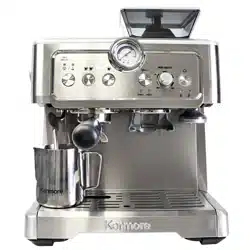Loading ...
Loading ...
Loading ...

OPERATING YOUR MACHINE
12
13
OPERATING YOUR MACHINE
BREWING ESPRESSO
THE PERFECT EXTRACTION
The word espresso refers to a method of brewing coffee in which hot water is forced under
pressure through tightly packed, finely ground coffee beans. The resulting espresso shot can be
enjoyed on its own or combined with heated, textured milk to make a variety of espresso drinks.
There are a few simple terms that are important to understand as you learn to pull the perfect
shot: Grind, dose, tamp, time, and yield.
Grind refers to the size and consistency of your ground coffee beans. Changing the grind size will
impact the taste of the finished shot, with a finer grind providing more surface area and slower
water flow for increased flavor extraction and a coarser grind doing the opposite. Your built-in
burr grinder lets you adjust the grind size while ensuring a uniform consistency.
Dose refers to the amount of dry ground coffee that you put in your portafilter basket. An ideal
dose can range from 7-11 g for a single shot and 14-22 g for a double shot, depending on your
espresso style. Your machine is equipped for both automatic and manual coffee dosing.
The tamp is the act of pressing the ground coffee into the portafilter with a tamper to create a
solid, evenly compacted "puck." A proper tamp ensures an even flow of water and consistent
extraction throughout the grounds. Too light a tamp will let the water run through too quickly,
resulting in an under-extracted shot and vice-versa.
Time refers to how long, in seconds, the hot water takes to run through the ground coffee in the
portafilter and into the cup, and yield refers to the amount of liquid coffee produced, measured
by weight or volume. The ideal extraction time for a typical espresso shot is 25-35 seconds, with a
yield of approximately 1.2 oz (35 mL) for a single shot or 2 oz (60 mL) for a double.
Checking your extraction times and adjusting your grind, dose, and tamp will help you perfect
your technique so you can pull a balanced shot every time!
CHOOSING A FILTER BASKET
Your machine includes two pressurized (double-
wall) filter baskets. Pressurized filter baskets are
designed to minimize the impact of grind, dose,
tamp, or freshness on the quality of the finished
shot. The bottom of a double-wall filter basket
consists of two layers (Figure 6). After passing
through the grid of tiny, regularly spaced holes
in the upper layer, the coffee is forced through
the single hole in the bottom layer, resulting in a
thick layer of rich crema.
1-CUP OR 2-CUP
Use the 1-cup filter basket when making a single
shot of espresso. Use a 2-cup filter basket to
make a "doppio" or double shot, to brew a
stronger single with a larger dose of ground
coffee, or place two cups below the portafilter
spout to divide the espresso into two singles
(Figure 7).
PURGING THE GROUP HEAD
Running hot water through the group head to
"purge" it before attaching the portafilter helps
stabilize the temperature and wash away any
residue from previous shots. With the machine in
standby (preheated) mode, press the button
and let the water run through into the drip tray
or an empty cup until it stops on its own.
INSERTING THE FILTER BASKET
The filter baskets are designed with locking
"dots." These small metal nodes fit into a groove
in the portafilter to prevent the basket from
falling out when you knock out a used coffee
puck.
1. Place the basket in the portafilter with the
notched edge facing you and tilted slightly
upwards. (Figure 8)
2. Align the node (just below the notch) with the
vertical groove in the portafilter. Let the filter
basket drop into place and then rotate it slightly
in either direction to lock. (Figure 9)
Fig. 6
Fig. 7
Fig. 9
Fig. 8
Loading ...
Loading ...
Loading ...
